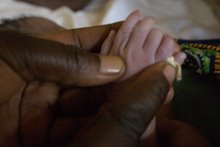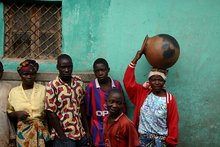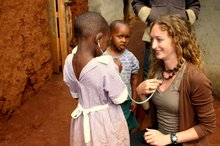 Today I saw an operation for a skin graft on an 8 y.o. boy, one of my favorite patients at Shyira. He has a playful attitude, a beaming smile, and a limp. His right shin is wide open and has been for years. He has chronic osteomyelitis—infection of the bone.
Today I saw an operation for a skin graft on an 8 y.o. boy, one of my favorite patients at Shyira. He has a playful attitude, a beaming smile, and a limp. His right shin is wide open and has been for years. He has chronic osteomyelitis—infection of the bone.Osteomyelitis usually infects the bone through 1)bacteria traveling through the blood that finds a home on the bone or 2)through a deep injury (or surgery) that gives the bacteria access to traumatized bone.
In America osteomyelitis is not common. Injection drug users and patients with intravenous catheters are two small groups at risk for bacteria introduced into the blood. However, after working in Uganda and Rwanda, I no longer consider it astonishing to see patients with deep wounds that will not heal, with infections that have persisted for years or children limping because osteomyelitis has kept their infected bone from growing.
Staphylococcus aureus is a bacteria that normally grows on our skin. The Kings have both commented that the Staph in Africa seems unusually vicious. Combined with the differences in sanitation, it causes problems. Just this week I’ve seen a liter in total of pus drained from patients coming in with abscesses caused by Staph. Two patients had fingers amputated that were taken over by the bacteria. It is also the most common cause of osteomyelitis. When in the blood it settles most commonly in the long bones or vertebral bodies. If untreated it can cause an avascular necrosis of bone. In children this is especially disastrous because it causes a stunt in their growth. Another mechanism is through a wound providing direct contact to the bone. If a wound is deep enough the bacteria can settle in the bone, so treatment requires surgical debridement and IV antibiotics. However not all patients in Africa will come in for cleaning of their wounds.
The small boy had skin grafted from his thigh to cover the gaping wound on his shin. With this and antibiotics hopefully his leg will heal and he won’t have to continue his childhood using a cane.













1 comment:
Have you ever noticed your brother, Jon's, bow-leggedness? I was told that it was from his cirrhosis. His liver had not been supplying his body with the needed nutrients for some time so the body turned to his bones to supply what it needed. This led to the curvature we now see in his lower legs. It effected his ability to point his toes. This was noticed during his freshman year on the swim team.
After discovery of his liver condition and his eventual return to "stability", we pursued "straightening" his curved lower limbs with a physical therapist. Exercizes were recommended but we were told that it would require a diligence that I wasn't sure Jon would maintain.
So, it was left alone - didn't know if you knew all that. Mom
Post a Comment